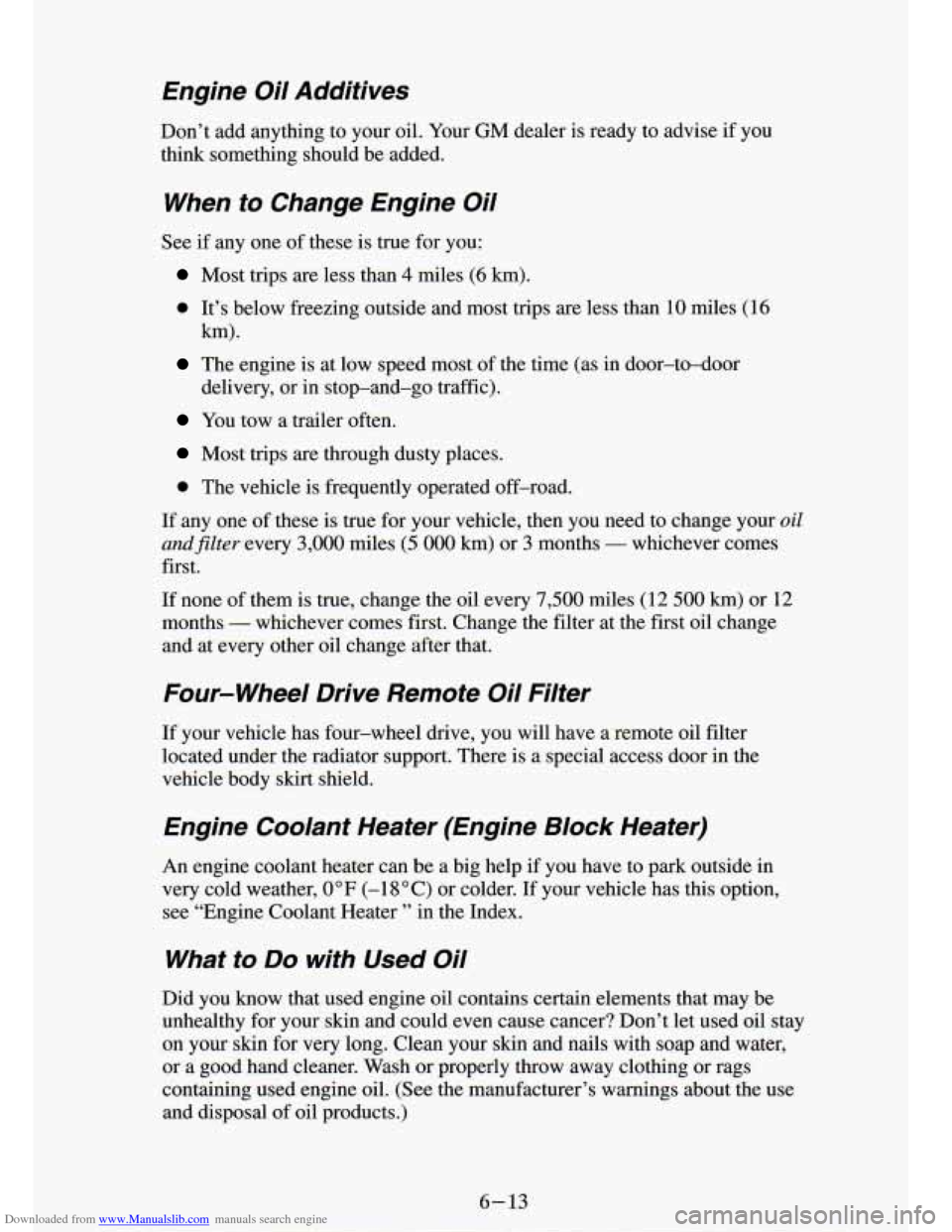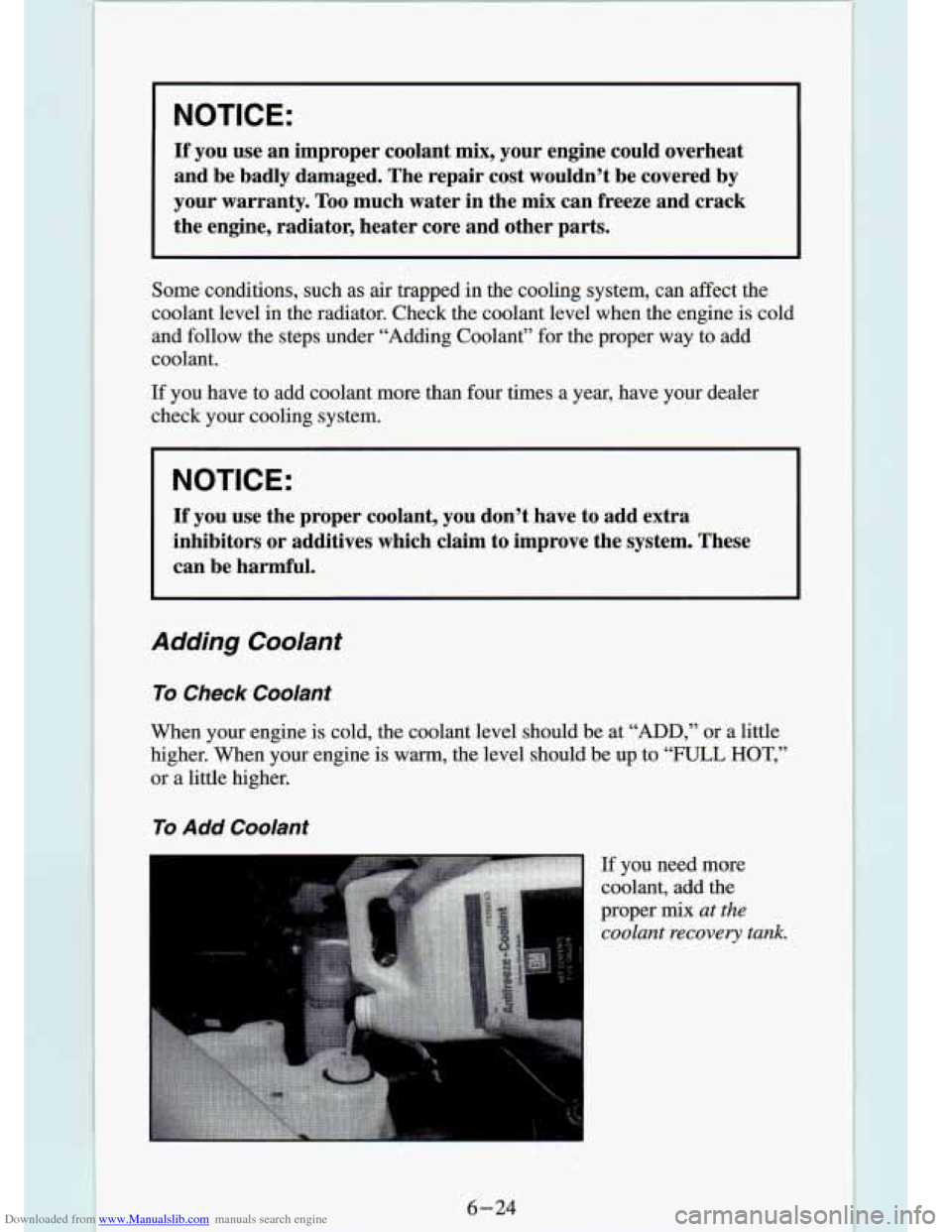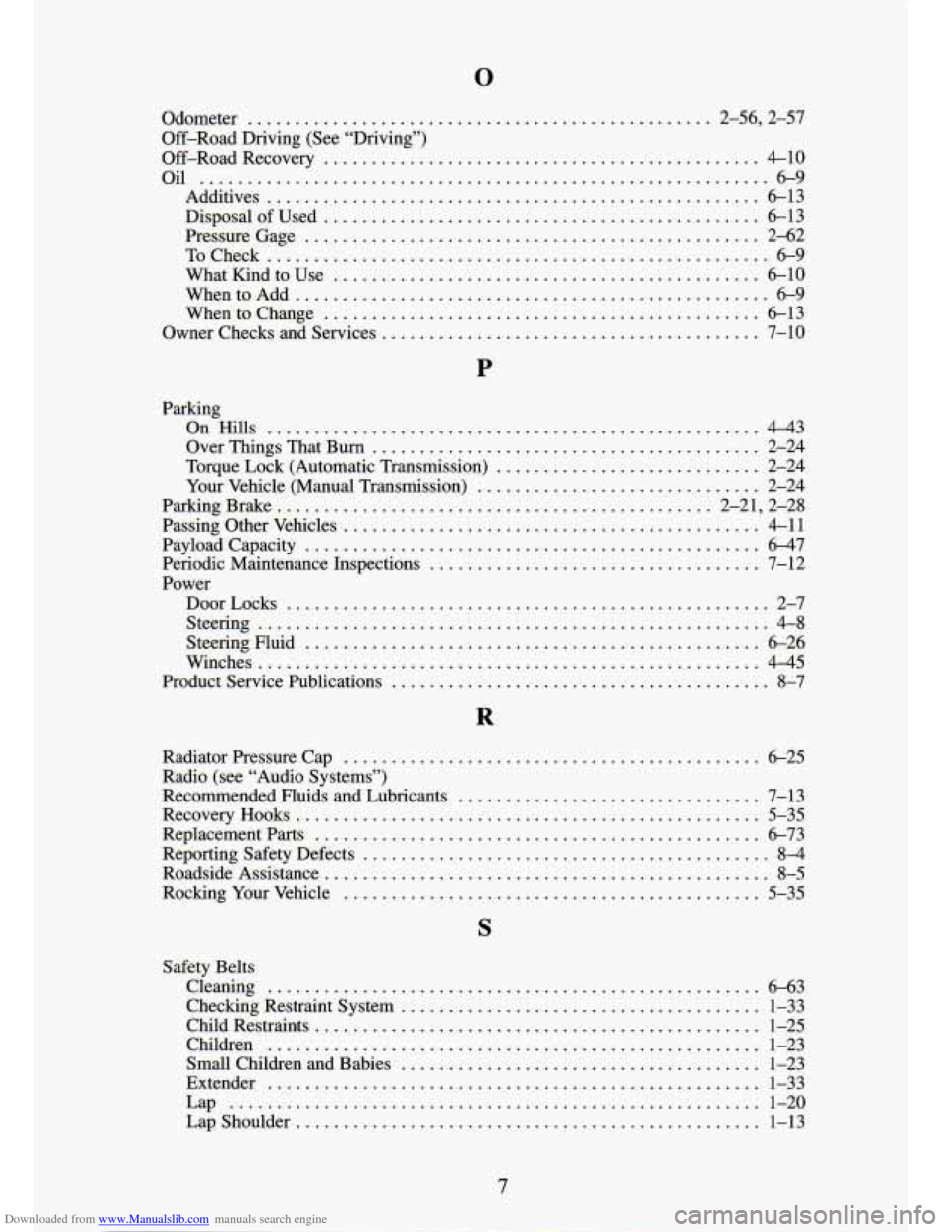1994 CHEVROLET S10 oil additives
[x] Cancel search: oil additivesPage 222 of 340

Downloaded from www.Manualslib.com manuals search engine Gasolines for Cleaner Air
Your use of gasoline with deposit control additives will help prevent
deposits from forming in your engine and fuel system. That hel\
ps keep your
engine
in tune and your emission control system working properly. It’s \
good
for your vehicle, and you’ll be doing your part for cleaner air.
Many gasolines are now blended with oxygenates. General Motc
recommends that you use gasolines with these blending niaterials,
sucn as
MTBE and ethanol. By doing so, you can help clean the air, especially in
those parts of the country that have high carbon monoxide levels.
In addition, some gasoline suppliers are now producing reformulated
gasolines. These gasolines are specially designed to reduce vehi\
cle
emissions. General Motors recommends that you use reformulated g\
asoline.
By doing
so, you can help clean the air, especially in those parts of the
country that have high ozone levels.
You should ask your service station operators
if their gasolines contain
deposit control additives and oxygenates, and if they have been\
reformulated to reduce vehicle emissions.
Fuels in Foreign Countries
If you plan on driving in another country outside the U.S. or Canada,
unleaded fuel may be hard to find. Do not use leaded gasoline. If you use
even one tankful, your emission controls won’t work well or \
at all. With
continuous use, spark plugs can get fouled, the exhaust system \
can corrode, and your engine oil can deteriorate quickly. Your vehicle’s oxygen sensor
will be damaged. All of that means costly repairs that wouldn’t be covered
by your warranty.
To check on fuel availability, ask an auto club, or contact a ma\
jor oil
company that does business in the country where you’ll be d\
riving.
You can also write us at the following address for advice.
Just tell us where.
you’re going and give your Vehicle Identification Number (VI\
N).
General Motors Overseas Distribution Corporation
North American Export Sales (NAES)
1908 Colonel Sam Drive
Oshawa, Ontario
L1H 8P7
6-4
Page 231 of 340

Downloaded from www.Manualslib.com manuals search engine Engine Oil Additives
Don’t add anything to your oil. Your GM dealer is ready to advise if you
think something should be added.
When to Change Engine Oil
See if any one of these is true for you:
Most trips are less than 4 miles (6 km).
0 It’s below freezing outside and most trips are less than 10 miles (16
km).
The engine is at low speed most of the time (as in door-to-door
delivery, or in stop-and-go traffic).
You tow a trailer often.
Most trips are through dusty places.
0 The vehicle is frequently operated off-road.
If any one of these is true for your vehicle, then you need to change your oil
andfilter every 3,000 miles (5 000 km) or 3 months - whichever comes
first.
If none of them is true, change the oil every
7,500 miles (12 500 km) or 12
months - whichever comes first. Change the filter at the first oil change
and at every other oil change after that.
Four-wheel Drive Remote Oil Filter
If your vehicle has four-wheel drive, you will have a remote oil filter
located under the radiator support. There is a special access \
door in the
vehicle body skirt shield.
Engine Coolant Heater (Engine Block Heater)
An engine coolant heater can be a big help if you have to park outside in
very cold weather,
0 “F (-1 8 O C) or colder. If your vehicle has this option,
see “Engine Coolant Heater
” in the Index.
What to Do with Used Oil
Did you know that used engine oil contains certain elements that may be
unhealthy for your skin and could even cause cancer? Don’t let used oil stay
on your skin for very long. Clean your skin and nails with soap and water,
or a good hand cleaner. Wash or properly throw away clothing or rags
containing wed engine oil. (See the manufacturer’s warnings about the use
and disposal of oil products.)
6-13
Page 242 of 340

Downloaded from www.Manualslib.com manuals search engine I NOTICE:
If you use an improper coolant mix, your engine could overheat
and be badly damaged. The repair cost wouldn’t be covered by
your warranty. Too much water in the
mix can freeze and crack
the engine, radiator, heater core and other parts.
Some conditions, such as air trapped in the cooling system, ca\
n affect the
coolant level in the radiator. Check the coolant level when th\
e engine
is cold
and foilow the steps under “Adding Coolant” for the proper way to add
coolant.
If you have to add coolant more than four times a year, have your dealer
check your cooling system.
I NOTICE:
If you use the proper coolant, you don’t have to add extra
inhibitors or additives which claim to improve the system. These
can be harmful.
Adding Coolant
To Check Coolant
When your engine is cold, the coolant level should be at “ADD,” or a little
higher. When your engine is warm, the level should be up to
“FULL HOT,”
or a little higher.
To Add Coolant
I
If you need more
coolant, add the
proper
mix at the
coolant recovery tank.
6-24
Page 333 of 340

Downloaded from www.Manualslib.com manuals search engine 0
Odometer ................................... ............. 2.56. 2.57
Off-Road Driving (See “Driving”)
Off-RoadRecovery
.............................................. 4-10
Oil
............................................................ 6-9
Additives
.................................................... 6-13
DisposalofUsed
.............................................. 6-13
Pressure Gage
................................................ 2-62
ToCheck
..................................................... 6-9
WhatKindtoUse
............................................. 6-10
WhentoAdd
.................................................. 6-9
Whentochange
.............................................. 6-13
Owner Checks and Services
........................................ 7-10
Parking On Hills
.................................................... 4-43
Over Things That
Burn ......................................... 2-24
Torque Lock (Automatic Transmission)
............................ 2-24
Your Vehicle (Manual Transmission)
.............................. 2-24
ParkingBrake
.............................................. 2.21, 2.28
Passing Other Vehicles
............................................ 4-11
Payload Capacity
................................................ 6-47
Periodic Maintenance Inspections
................................... 7-12
Power DoorLocks
................................................... 2-7
Steering
...................................................... 4-8
SteeringFluid
................................................ 6-26
Winches
..................................................... 4-45
Product Service Publications
........................................ 8-7
R
Radiator Pressure Cap ...... 6-25
Radio (see “Audio Systems”)
Recommended Fluids and Lubricants
................................ 7-13
RecoveryHooks
................................................. 5-35
Replacement Parts
............................................... 6-73
Reporting Safety Defects
........................................... 8-4
Roadside Assistance ............................................... 8-5
Rocking Your Vehicle ............................................ 5-35
Safety Belts
Cleaning
.................................................... 6-63
Checking Restraint System
...................................... 1-33
ChildRestraints
............................................... 1-25
Children
.................................................... 1-23
Small Children and Babies
...................................... 1-23
Extender
.................................................... 1-33
Lap
........................................................ 1-20
Lapshoulder
................................................. 1-13
7